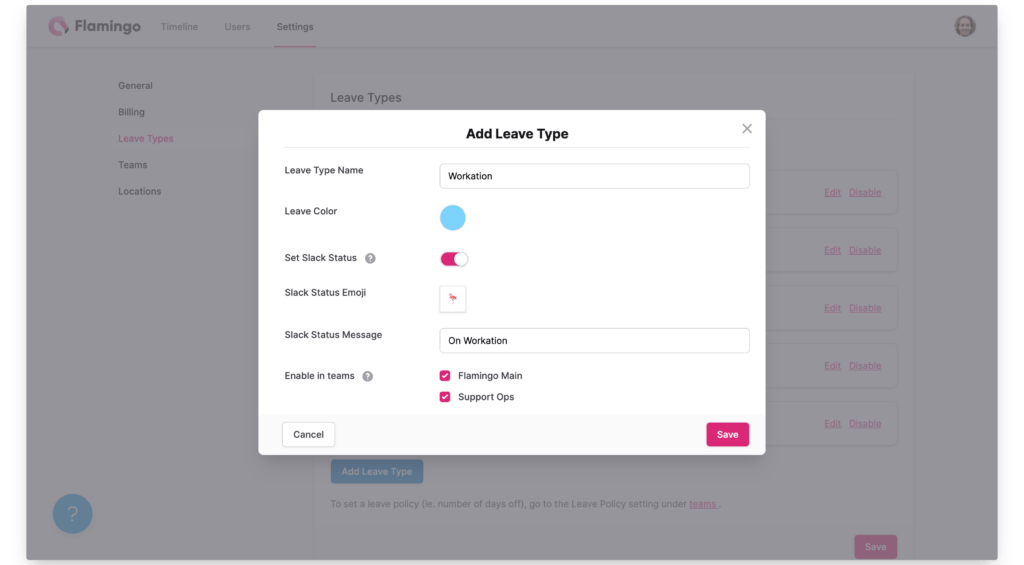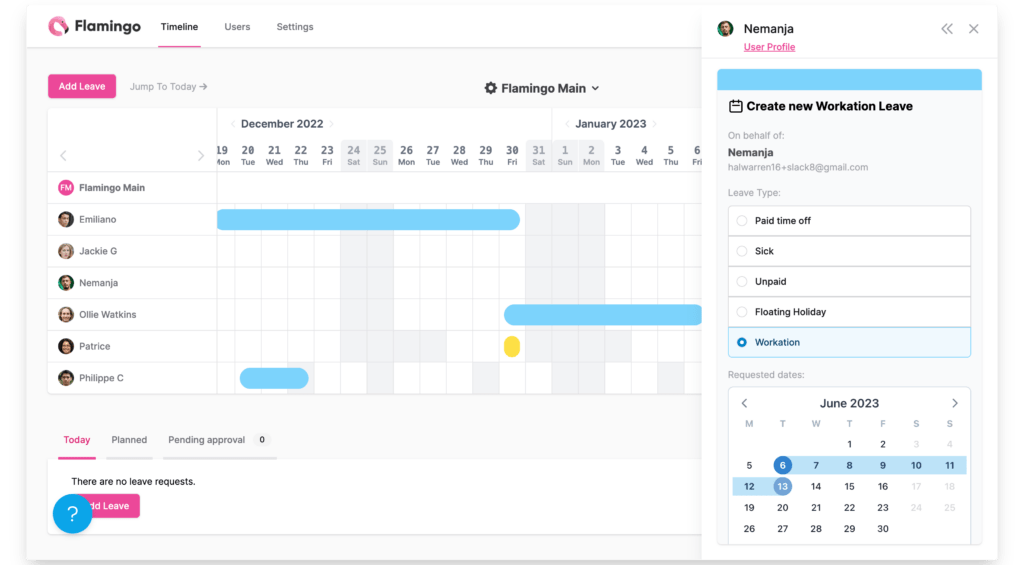April 23, 2024
What is Garden Leave? (Aka Gardening Leave)
Key Takeaways:* Garden Leave, or Gardening Leave, is when an employee leaves their job and is asked to stay a...

The workation is the latest trend that’s part of a huge shift in the way most people work.
Fewer people and workplaces subscribe to the traditional 9-5 office-based model, where you’re chained to your desk for 40 hours a week. As a whole, we value flexibility and work-life balance more than we used to, and many businesses are choosing to accommodate this.
If you’re curious about workations, either as a worker, HR professional or a manager/leader of a team, read on. We’ll share all you need to know, from the definition and objective of a workation, through to their pros and cons.
Further Reading: Do We Really Need the 40 Hour Work Week?
A workation (a term made by combining the words “work” and “vacation”) refers to when a worker travels to a vacation-type location, yet continues to work remotely while doing so.
Some may refer to this instead as a workcation, worcation, workoliday, woliday, or some other term.
An easy way to think of it is as working during a vacation. The person typically travels to an exotic location, the type of which people usually go for a holiday or vacation, and does their work from this place instead of the office.
In essence, there’s very little difference between a workation and just working remotely, or living as a “digital nomad”.
The one distinction is that a workation, in most cases, is a shorter-term thing. A person might take a week, two week or month-long workation, whereas being a digital nomad and working from anywhere is generally a more permanent arrangement.
The difference between taking a workation and asking to work remotely for a period of time is even smaller – perhaps non-existent. The idea is the same, and in a business that allows hybrid or remote working, there may be no need to make the distinction between remote work, work from home and a workation.
Of course it’s important to remember that, as a new concept, a workation or workcation doesn’t mean the same thing everywhere. The definition of a workation may be different in one business from another.
The idea of a workation is to give workers flexibility, the ability to go to a fresh environment, visit new places and take a break from the monotony of their everyday working environment, while still getting work done.
Usually you’ll need to save up and spend your vacation days to do this. That might mean someone can only take a maximum of a few weeks each year to travel and see the world.
With a workation, you have more time to travel to new places. Even though you spend more time away from the office, you can still get your work done, the business doesn’t have to deal with as much of a loss in productivity.
Though we mentioned earlier that a workation is kind of like “working on vacation”, it’s important to separate the two.
With the ability in many jobs to log in from your laptop and work from anywhere with a strong internet connection, many people actually do work on their vacation. Despite filing their time off request and taking vacation days, they still end up checking and answering emails, logging into Slack, etc.
This is not good. A vacation should be a clean break from work. A chance to disconnect, rest and refresh.
Working on vacation is a leading cause of burnout, which affects a large percentage of the workforce today.
A workation should be distinct from a vacation. You may take a week-long workation to Cabo, but you also need an actual vacation sometime, when you switch off and don’t work.
Some businesses may try to finagle it by justifying a lower allowance of vacation days in return for allowing employees to take workations, in the hope that they’ll get more productive hours and save on vacation pay. But understand the negative long-term effects of employee burnout that will come as a result.
Workations are increasingly popular with workers today.
In Japan, the market for workations is estimated to be worth in excess of 100 billion Yen.
Simon Kucher & Partners conducted a study of over 7,000 workers in China, France, Germany, Netherlands, Russia, Great Britain and the US. Of these respondents, 80% said they would like to stay longer in their vacation locale, by adding on a couple of weeks of “workation” at the end of their vacations.
Another study of 3,000 Indian workers found that 85% took a workation in 2021, while a similar study of 5,500 people across the globe had 65% respond and say they planned to extend a vacation with a working trip or workation.
On the whole, it’s clear that a lot of us are enamored with the idea of being able to travel to exotic new locations while still working and preserving our vacation days. It’s the same reason remote work has become such a popular employee benefit in the world today.
There’s no standard definition of a workation. It can work a number of different ways.
Generally, though, you’ll see workations split into short, medium and long-term. Let’s look at these different types of workations now.
A short workation is generally a getaway of just a few days, perhaps up to a week. The idea is to get a quick refresher or break from your home base, to a location not far away and not requiring too much travel.
Short term workations may also be an extension of a weekend break – for example, you might go away for Saturday and Sunday and stay on working remotely at the location for a few more days.
A medium term workation generally lasts several weeks. It’s an opportunity to travel further, and get a more extensive break from home, without taking a full vacation.
This could be combined with an actual vacation. For example, you might take a week-long vacation to fully immerse yourself in your destination, and follow that with a 1-2 week workation by resuming work but remaining in the vacation destination.
You might also take a longer workation, which is basically the same as adopting the digital nomad lifestyle.
You could use this time to travel the world, see many new places, or simply go to a new place and really immerse yourself in a new location and new culture.
(Be sure to consider the tax and visa implications if you choose to go on a long-term workation in one country. You may be violating local laws by working on a tourist visa, so take this into account).
Here are some of the key benefits that workations offer to employees and employers.
More and more people today value flexibility in their job.
The rigidity of the 9-5 office schedule is draining. That’s a large part of our lives we spend chained to the office, limiting the time we have to spend with loved ones, or to have new and exciting experiences.
We end up working for the weekend, or “doing time” until our yearly vacation comes along.
Workations give us greater flexibility to live a full life, while still meeting our professional commitments and earning a living.
This is true with remote work in general – over 60% of remote workers say flexibility is the top benefit of being able to work from anywhere.
The increased flexibility also means a more fulfilling and healthy work-life balance.
By working on the go, we can pay more attention to our personal lives alongside our work lives.
Workcations/remote work gives you more freedom to do things you always wanted to do outside of work, by removing the constraints of always working from the same location.
A workation is a great way to refresh and reset your mindset. This is often enough, on its own, to stave off burnout.
Burnout often comes from a work-life imbalance, a repetitive routine, and environmental issues. Workations, even of just a few days, offer an escape from that, and are likely to reduce the risk of burnout as a result.
Learn More: dive deeper into the 5 Stages of Employee Burnout
The monotony of the same environment, the same routine, is a drain on creativity. It leaves us stuck in a rut, where we struggle to find creative inspiration.
Taking a workation and working from a new environment is refreshing, and a successful workation may result in a brand new outlook that’s beneficial for creative thought and overall productivity.
Speaking from the company’s perspective, workations can be a powerful tool to boost employees’ job satisfaction and retention rates.
Workers are generally going to be happier to have the opportunity to travel and see new places more often, which decreases the risk that they’ll become unhappy and decide to look for a new job.
It would be amiss to ignore the potential downsides of workations as well. Here are some issues that can arise with a workation.
Workation locations are not always fully conducive to productivity. You might have to deal with spotty internet, distractions, or trouble finding a productive workspace.
The lure of the beach right in front of you always makes it harder to stay seated, locked in and focused on your work.
In general, there may be an unspoken agreement that employees will be slightly less productive on a workation. This loss of productivity can add up if there’s a lot of time spent on workation.
Overall productivity of the business can be affected when someone goes on a workation by communication and collaborative struggles.
This is a problem that is not unique to workations, but one that applies to remote work in general. It’s important that a business guides its employees on how to communicate and collaborate effectively when working away from the office, and that you use the right tools for remote collaboration.
Though there should be a distinction between a workation and an actual vacation, it can lead to blurred lines, where workers don’t get the actual detachment they need from work.
It could be that the business substitutes vacations for workations, reducing vacation time allowance in return for more opportunities to take workations.
Alternatively, when workers do take an actual vacation, they might find themselves logging in, checking emails, getting a little work done, because they’re used to doing the same when on workation.
There are also some tax and legal issues to consider when employees travel to new places (particularly overseas) and work remotely.
This may be considered a breach of local laws, if an employee ends up working without the relevant work permits, or without paying tax.
These are out of our scope to explain, so companies may want to consult a legal professional, and if necessary place some stipulations on how/where employees can take workcations.
Ultimately, workations can be beneficial, as long as it’s possible to get work done and stay productive while working remotely.
It’s important to understand that workations are not a replacement for vacations. You still need time to fully detach yourself from work. But it can be a great thing to mix in short to medium-term workations, where you get to experience a new environment while still working and earning money.
If you’re a business owner or team leader and want to let your employees take workations, you’ll want to set the stage to ensure you can do so without the potential downsides.
First, unless your business is fully remote, you may want to treat workations as a form of leave. This may or may not have a limit attached (i.e. maximum of 20 days’ workation per year). But limit or not, employees should need to request permission for workations, and have the rest of the team notified that they’ll be away from the office, and potentially in a new location and time zone.
If your team uses Flamingo, it’s simple to set up a leave type for workations, to help keep everyone in the loop.


It’s also a good idea to give some tips on how employees can make the most of their workation, while remaining productive. Similar to a work from home policy, provide tools and guidance on working effectively away from the office.
Track workations, vacations, sick leave and any other type of time off using Flamingo, the easiest way for modern teams to manage leave.

So where’s the best place to take a workation?
It comes down to personal preferences. Realistically, you can go on a workation anywhere with electricity and a good internet connection, where you’re able to work effectively.
It doesn’t have to be somewhere by the beach like Cancun or Rio. A great workation location is anywhere you want to go. It could be the beach, it could be the mountains, or it could just be a new city you’d love to explore.
For a short workation, you generally want somewhere that’s a short drive or flight away, so you don’t use up too much of your time traveling.
For a longer workation, many people will want to consider places with a relatively low cost of living, where you can live affordably for a month or so (or potentially longer).
South and Central America are great locations for this, which attract many digital nomads due to how convenience as a remote work location. As are Eastern Europe and the Balkans, and locations like Thailand, Vietnam and Malaysia in Southeast Asia.
For long term workations, also look at countries that offer remote work visas, to ensure that everything you’re doing is above ground. Croatia, Estonia, Portugal and Malta are a few examples of places that allow digital nomads/remote workers to stay and work legally.
But ultimately, it’s up to you. If you want to take a workation in Wyoming or in Rome, it’s your choice.
Flamingo makes managing your team’s paid time off a breeze.